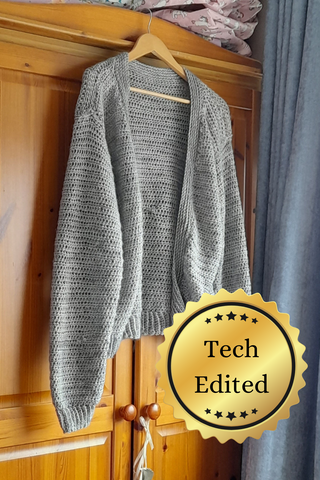Recently I've decided to really shout about tech editing and why it's a great reason to pay for patterns. Across this whole site, I am updating my pattern photos to include a tech edited badge. When I made this announcement on social media, a lot of people asked "what does tech edited mean?" so let me explain.
What does "tech edited" mean?
Tech editing is where a knitwear or crochet designer pays a professional editor to proof read, check for grammar, spelling, punctuation and clarity. A tech editor also checks the maths. If the maths is off, the pattern is going to be a minefield for the maker. As well as the maths and English (or preferred pattern language), the tech editor checks that the measurements, yarn requirements, gauge and other information are absolutely correct. Tech editors also offer grading services so that the measurements for each size of the garment add up!
I've decided to be more explicit about the fact that my patterns are tech edited. I usually put it in the description but now you can see even at a quick glance that I have paid an editor to professionally edit and review my patterns so you can access them with ease. You're paying for the privilege of not having to work it all out yourself!

A good designer will have their patterns tech edited to ensure that when you're purchasing a pattern from them, you're going to be able to make the item without difficulty and you know you're investing in a quality pattern.
Tech edited doesn't mean "free of errors" but it's a safe bet there won't be any.
As designers and tech editors are humans, there will sometimes be an issue with the instructions but this is rare with a tech edited pattern.
My tech edited badge is a way of showing you that I've invested a lot of time and money in creating patterns for you.
I don't have any free patterns and this is simply because they cost money to produce. If you've ever wondered why big yarn companies have so many free patterns available, it's because they make the money from selling their yarn, advertising partnerships etc. They pay commissioned designers to produce patterns for them with money they've earned through these channels. Therefore, pattern sales are not their main source of income and so they can offer their patterns for free.
You may come across free patterns from independent designers sometimes. If you had to scroll through a really wordy blog full of pop ups and ads to get to the instructions, that's because the ad revenue pays for the pattern. Sometimes, an independent designer will offer a free pattern as a "sample" or a gift for signing up to their newsletter, too. You will also find that in some cases, if the pattern is free, the designer does not have to offer pattern support. Why should they? They're not being paid for their time.
The majority of independent designers do not offer their patterns for free. This is simply because there are so many overheads that come with designing and publishing patterns by yourself. Take for example the Starburst cardigan (pictured). I paid £150 to my editor to have it checked so that you could make it without any issues. As I was offering this garment in sizes ranging from 26" to 52" chest, I had to make sure that this pattern was properly written! The only way to do that is to pay an editor.

What about testers?
Independent designers also use testers as part of the pattern production. Testers are an important part of the process but they are not tech editors. Often, a pattern tester is:
- A hobbyist (ie this is not their profession and relies on them having free time)
- A volunteer.
- Required to check that they can make the item from the instructions. They are not trained to edit and check for errors.
This is not to say that a tester can't spot errors- they absolutely can- but in my experience of using testers for patterns, the success can vary. If a pattern tester is a beginner (and has told you otherwise on their application), you can often end up holding their hand through the pattern and practically running a free tutorial. This is even more time intensive than regular testing.You should not use testers in place of an editor. They are not the same.
As there is no contract between you and your testers, they can abandon the project whenever they want. There is often no recourse for this. I've been ghosted by many a tester and there has been nothing I can do but go back to square one and find another tester.
If the pattern tester is advanced, they can overlook simple errors as their experienced minds can auto-correct and fix errors before they've even been highlighted.
There are disadvantages to using testers but even if you have a team of good testers, it is not fair to burden them with all of the weight that is editing your pattern. You need a professional.
I hope you found this post helpful! If you need a tech editor, here's a really good list from this directory.

